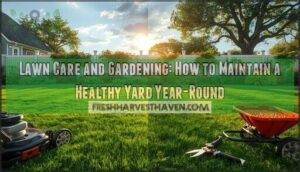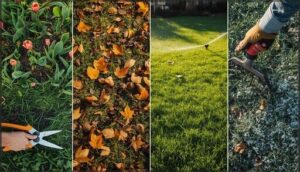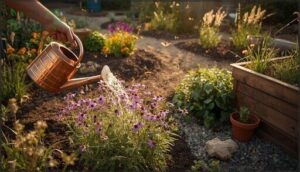This site is supported by our readers. We may earn a commission, at no cost to you, if you purchase through links.

Your lawn doesn’t need to look like a golf course, but it shouldn’t look like a hayfield either. Most homeowners fall somewhere in between—mowing when they remember, fertilizing once if they’re lucky, and wondering why their neighbor’s grass always looks greener.
The truth is, lawn care and gardening success isn’t about luck or endless hours of labor. It’s about timing, technique, and knowing which tasks actually matter. A sharp mower blade does more for your turf than expensive fertilizer applied at the wrong time. Pruning in late winter beats hacking away at branches in July.
Small adjustments to your routine—based on how grasses and plants actually grow—create yards that thrive with less effort, lower costs, and results that last all year.
Table Of Contents
Key Takeaways
- Lawn health depends on timing and technique rather than expensive products—sharp mower blades, proper cutting heights (2.5-3.5 inches for cool-season grass), and September fertilization (1-1.5 pounds nitrogen per 1,000 sq ft) deliver better results than guesswork.
- Deep, infrequent watering (1-1.5 inches weekly, reaching six inches deep) and early morning irrigation build drought-resistant roots while cutting evaporation waste by over 30% compared to frequent shallow watering.
- Seasonal maintenance shifts dramatically throughout the year—fall demands core aeration and overseeding for cool-season turf, summer requires raising mowing heights to 3-4 inches, and spring cleanup directly boosts property values by 7-14%.
- DIY lawn care saves roughly $270 annually but costs over 100 hours per season and carries injury risks averaging $37,000 in medical expenses, while bundled professional packages often match DIY equipment costs long-term without the safety hazards.
Essential Lawn Care Practices
Your lawn doesn’t just happen—it’s the result of consistent, well-timed care that builds on itself throughout the year. Getting the basics right means understanding how each essential practice works together to create resilient turf that can handle stress, competition, and seasonal changes.
A lush, resilient lawn is built on consistent, well-timed care that helps turf thrive through every season and challenge
Here’s what you need to master to keep your yard healthy and thriving.
Mowing, Trimming, and Edging Techniques
Master your lawn’s appearance and health with smart mowing, trimming, and edging habits. Keep cool-season grass between 2.5 and 3.5 inches most of the year—raising it to 3 or 4 inches in summer cuts heat stress. Follow the one-third rule: never remove more than a third of the blade in one pass.
For polished yard work:
- Mow weekly during peak growth to respect cutting heights and avoid scalping.
- Sharpen mower blades every 20 to 25 hours for clean cuts.
- Edge sidewalks and beds once or twice yearly to define boundaries.
- Wear hearing protection around gas equipment—many mowers hit 85 to 100 decibels.
Understanding proper lawn mowing heights is essential for a healthy lawn.
Fertilization Schedules for Healthy Lawns
Your grass needs the right nutrients at the right time. Cool-season lawns thrive on 2 to 4 pounds of nitrogen per 1,000 square feet yearly, split across multiple applications. September stands out as the most important fertilization month—apply 1 to 1.5 pounds of nitrogen then for vigorous root growth.
| Grass Type | Peak Feeding Window | Annual Nitrogen Rate |
|---|---|---|
| Cool-season (bluegrass, fescue) | August–November | 2–4 lb per 1,000 sq ft |
| Warm-season (zoysia) | Late spring–summer | 2–4 lb per 1,000 sq ft |
| High-maintenance lawns | Monthly fall applications | Up to 4–5 lb per 1,000 sq ft |
| Low-input lawns | Two applications yearly | 2 lb per 1,000 sq ft |
| New seedings | Starter with phosphorus | Adjust after soil testing |
Start with soil testing to avoid over-fertilizing phosphorus. For established lawns showing adequate phosphorus levels, skip it entirely and focus on nitrogen and potassium. Limit single nitrogen applications to 0.7 to 1 pound per 1,000 square feet using slow-release formulas—at least 30 to 50 percent slow-release in late summer maintains color for weeks without burn risk. Understanding soil test results is essential for determining the right fertilizer application.
Time your fertilization with active growth periods. Avoid heavy nitrogen on cool-season grass in midsummer, as it leads to heat stress and disease. Warm-season turf benefits most from late May and mid-August feedings when recovery demands peak. Skip July applications on non-irrigated warm-season lawns to prevent burn.
Quick-release fertilizers green up lawns fast but require reapplication every two to four weeks, raising annual costs to over $300. Slow-release products stretch intervals to three to six months and deliver steady lawn nutrition. Align your fertilization schedule with rainfall patterns and never fertilize during dormancy—nutrient runoff harms water quality while your lawn gains nothing.
Weed Control and Removal Methods
Weeds steal water and nutrients your fertilized lawn desperately needs. You have four proven approaches to reclaim your turf:
- Pre-emergent herbicides applied before seeds germinate – watered in with 0.5 to 1 inch of irrigation
- Hand-pulling entire root systems – targets small infestations without damaging surrounding grass
- Corn gluten meal reducing populations 40 to 60 percent – natural option requiring precise timing
- Mulch layers suppressing emergence over 90 percent – wood chips at 7.5 to 10 centimeters in beds
Rotate methods to prevent herbicide resistance while protecting your lawn’s health.
Aeration and Overseeding Tips
Once weeds are under control, it’s time to renew your lawn’s health with core aeration and overseeding. Early fall offers ideal overseeding timing for cool-season turf, while late spring suits warm-season grasses.
Good soil preparation—removing plugs two to three inches deep—boosts seed germination and root mass. Choose resilient seed varieties for lasting lawn wellness and easier turf management.
Watering Best Practices for Lawns
Proper lawn hydration keeps turf thriving without wasting water. Your lawn needs 1 to 1.5 inches weekly—from rain or irrigation systems—to reach roots six inches deep. Water early morning to cut evaporation and boost water efficiency.
Deep, infrequent sessions promote soil moisture retention and stronger roots.
Use a rain gauge to track rainfall, then adjust your watering schedule for ideal lawn health and real water conservation.
Seasonal Lawn and Garden Maintenance
Your lawn doesn’t need the same care in January that it does in July. Successful year-round maintenance means knowing what to do when, adjusting your approach as temperatures shift and grass growth patterns change.
Here’s how to keep your yard thriving through every season.
Spring Cleanup and Preparation
Think of spring cleanup as waking your yard from winter’s sleep. Start by clearing debris from your lawn, which boosts curb appeal and can even raise home value by 7% to 14%.
Follow with lawn aeration—it addresses soil compaction and makes spring fertilization way more effective. These seasonal yard care steps set you up for a thriving landscape all season.
Summer Lawn Care Strategies
Summer heat can make or break your lawn’s health—it’s all about staying ahead of the stress. Mow cool-season grasses at 3 inches to reduce heat damage, and water deeply 2 to 3 times per week, bumping up to 4 during peak temperatures. Apply nitrogen fertilizer early in the season for density. Consistent lawn care keeps your turf resilient when temperatures climb.
Fall Fertilizing and Overseeding
September is the prime window for fall fertilizers—your cool-season lawn’s growth cycle peaks, making nutrient uptake incredibly efficient.
Overseeding for a better lawn works best now, especially when paired with lawn aeration to boost soil nutrients.
Apply 1.0 pound of nitrogen per 1,000 square feet when you fertilize your lawn, and watch turf recovery accelerate before winter arrives.
Winterizing Your Lawn and Garden
Your lawn enters dormancy once temperatures drop below 50°F, so a few smart moves before the first hard freeze will prevent costly spring repairs. Late-season lawn care protects turf crowns and roots when cold arrives.
- Keep cool-season grass at 2.5–3 inches during final mowing to balance disease risk and frost protection
- Remove thick leaf layers promptly—they smother turf and invite snow mold under winter moisture
- Apply winterizer fertilizer to strengthen roots and boost spring green-up
- Drain irrigation lines and disconnect hoses before freezing to avoid pipe cracks
- Spread 3 inches of organic mulch over perennial beds to moderate soil temperature swings
Clean tools thoroughly and coat metal surfaces with protective oil before storing them in a dry location for the season.
Adjusting Care for Different Grass Types
Your turf thrives when you match practices to its biology. Cool-season varieties like Kentucky Bluegrass need 2.5–3.5-inch mowing heights and four annual fertilizations, while warm-season Bermuda prefers 1–2 inches with spring-summer feeding. Soil pH management between 6.0–7.0 slows thatch, and proper watering schedules—1 inch weekly for most grass species—build drought resistance. Grass type identification guides every decision from fertilizer application to mowing height adjustment, protecting your lawn health investment year-round.
| Grass Type | Mowing Height | Fertilization Timing |
|---|---|---|
| Kentucky Bluegrass | 2.5–3.5 inches | Late May, July, Sept, Nov |
| Bermuda Grass | 1–2 inches | Spring & Summer |
| Tall Fescue | 3–4 inches | Late May, July, Sept, Nov |
Gardening and Landscape Design Tips
A beautiful yard starts with smart choices about what you plant and where you put it. Your landscape should work with your soil, support the environment, and give you space you actually want to use.
Here’s how to design a yard that looks great and fits your life.
Choosing The Right Plants and Shrubs
Your landscape succeeds or fails based on plant hardiness—match species to your zone’s minimum temperatures and you’ll skip 40% of the survival headaches. Native species like Lespedeza bicolor support pollinators naturally while demanding less fuss.
Look for compact, bushy shrubs over leggy ones—they branch better and fill space faster. Consider mature height, light needs, and garden aesthetics from day one, and your yard work becomes easier every season.
Soil Health and Nutrient Management
Test your soil every 2–3 years—it’s the only way to know exactly what nutrients you’re short on and which ones are already high. Over 40% of gardeners overuse phosphorus when they test first and fertilize smart. Match fertilizer type, amount, timing, and placement to lab results, and you’ll build healthier soil while cutting waste.
- Send samples to accredited labs for crop-specific nutrient recommendations
- Apply organic matter like compost to boost microbial health and nutrient cycling
- Time fertilizer applications near planting for better nitrogen use efficiency
- Use no-till practices to increase soil aggregation and improve root development
- Add mulch to suppress weeds and retain moisture while feeding beneficial microbes
Sustainable and Eco-Friendly Gardening
You’ll cut chemical use, save water, and feed the soil when you shift to sustainable gardening practices. Native plants slash irrigation needs while supporting pollinators—communities adopting them saw a 12% jump in wildlife certifications.
Organic pest control and composting build resilient ecosystems without synthetic inputs. Hand watering uses 33% less water than automated systems, and regenerative techniques like no-till gardening strengthen carbon sequestration while protecting local biodiversity.
Creating Functional Outdoor Spaces
Your outdoor spaces work harder when you zone them by purpose—cooking, dining, lounging. Nearly half of landscape design experts recommend this approach because it maximizes usability.
Start with covered patios for year-round comfort, then add fire features to extend seasonal use. Smart landscaping means proper outdoor lighting for evenings and multifunctional furniture that adapts as you need it.
Garden zones define themselves naturally with strategic plantings.
Hardscape Features for Enhanced Curb Appeal
When buyers see polished walkways and well-lit patios, they’re willing to pay nearly $9,200 more—walkways rank as the top curb appeal feature for 88% of homeowners.
Hardscape ROI reaches 100% in competitive markets, with patio designs and outdoor lighting directly raising property value.
Retaining walls control erosion while adding usable space. Professional landscape services deliver hardscapes that balance beauty with lasting function.
Tree and Shrub Care Essentials
Trees and shrubs form the backbone of your landscape, but they need more than occasional attention to truly thrive.
Proper care keeps them healthy, safe, and attractive while protecting your property investment.
Here’s what you need to know to maintain strong, beautiful trees and shrubs throughout every season.
Tree Trimming and Pruning Techniques
Pruning isn’t about whacking off branches—it’s about reading what your tree needs. Start by removing dead or crossing limbs with clean cuts just outside the branch collar.
Here’s how crown reduction works best:
- Remove no more than 30–40% of foliage in one session
- Time major cuts for late winter dormancy
- Use bypass pruners for stems under 2.5 cm
- Thin crowns selectively, never top
- Schedule follow-up inspections every 2–3 years
Proper branch management keeps trees healthy and structurally sound season after season.
Safe Tree and Stump Removal
Removing a tree near power lines or structures demands respect for real danger. Electrical Hazard Mitigation starts with calling your utility—7,200 volts can kill on contact.
Stump Grinder Hazards include entanglement and projectile debris, causing limb and facial injuries in over half of documented incidents.
For complex Tree Removal Safety and Injury Risk Assessment, hire certified arborists. Their Arborist Certification means proper training in fall protection and hazard recognition during Tree Services.
Planting and Maintaining Healthy Trees
A tree’s first year determines the next fifty. When you’re planting, dig your hole 2 to 3 times wider than the root ball but keep depth shallow—the root flare should sit slightly above grade for proper Root Development.
Then focus on these four essentials:
- Apply 2 to 4 inches of mulch in a wide ring, never touching the trunk
- Water 1 gallon per inch of trunk diameter weekly during establishment
- Remove only dead or broken branches at planting
- Schedule professional Tree Trimming around year four to build strong structure
Soil Preparation and Mulching Techniques lay the foundation, while expert Tree Services handle structural pruning that prevents future failures. Proper Tree Nutrition and Tree Planting methods integrate seamlessly with Landscape Design and Installation, ensuring your investment thrives for decades without requiring premature Tree Removal.
Managing Tree Health and Pests
You can’t defend what you can’t detect. Start with professional Disease Diagnosis—spotting leaf discoloration, cankers, or bark splitting before pests gain a foothold.
Integrated Pest Management combines Biological Solutions like beneficial predators with targeted Insect Management tactics. Your Tree Services provider will apply soil injections or eco-friendly sprays when needed, and strategic Pruning removes infected limbs to halt spread. Early Tree Pest Control protects Forest Ecology and prevents costly Tree Removal.
| Treatment Method | Best For | Timing |
|---|---|---|
| Soil injection | Systemic insects, disease resistance | Spring/Fall |
| Biological controls | Caterpillars, aphids | Active growth |
| Targeted sprays | Fungal infections, borers | Pre-symptom |
Emergency Tree Services and When to Use Them
When a split trunk threatens your roof or power lines tangle with fallen limbs, Emergency Response separates safety from catastrophe.
Storm Damage from severe weather accounts for over 70% of urgent calls nationwide. Act immediately if you spot:
- Leaning or cracked trunks near structures
- Hazardous Trees touching utility lines
- Partially uprooted roots after storms
Professional Tree Removal and Disaster Relief protect your property and prevent injuries during crisis situations.
Affordable Lawn and Garden Solutions
You don’t need to drain your bank account to keep your lawn healthy and thriving. The right approach balances smart spending with strategic choices that deliver lasting results.
Here’s how to get professional-quality care without the premium price tag.
Customizable Lawn Care Packages
You’ll find that customizable lawn care packages offer real control over your lawn health and wellness. Service bundles let you combine lawn mowing and edging with fertilization, aeration, or weed control based on your lawn analysis.
Custom pricing adjusts to your property’s needs, while maintenance plans keep your lawn care and maintenance consistent year-round.
Package options deliver flexibility without sacrificing quality—exactly what your landscape deserves.
DIY Vs. Professional Services
Deciding between DIY and professional lawn care services comes down to weighing cost comparison against time savings and safety risks. While DIY mowing can save around $270 annually, you’ll face equipment quality concerns and significant labor costs in hours—some homeowners spend over 100 hours per season. Plus, lawn mower injuries requiring surgery average $37,000 in medical expenses:
- Professional services eliminate injury risk entirely
- Commercial equipment delivers premium results consistently
- Time saved lets you enjoy your yard instead of maintaining it
- Bundled packages often cost less than DIY equipment over time
Budget-Friendly Lawn Care Strategies
You can achieve serious lawn cost savings without sacrificing quality—grasscycling alone cuts fertilizer needs by 25%, giving you free yard waste reduction while you fertilize your lawn naturally.
Switch to drought-tolerant grass for budget gardening that slashes water bills 40%, and try DIY landscaping with native plants requiring half the water of traditional turf.
These eco-friendly tips deliver affordable lawn care and outstanding yard care results.
Scheduling Regular Maintenance
Set up a lawn care schedule that matches your grass’s growth cycle—most properties thrive on near-weekly mowing during peak season, roughly every seven days.
Your maintenance schedules should include seasonal adjustments: weekly service frequency in spring shifts to three times monthly as summer heat slows growth.
Regular upkeep through seasonal lawn maintenance keeps your yard healthy while controlling costs with lawn care plans.
Tips for Maximizing Service Value
Bundle your lawn maintenance with add-on services like weed control or aeration—strategic service pricing through tiered lawn packages can boost customer retention while delivering real value. Companies offering eco-friendly options and transparent upsell strategies often see clients spending more yet feeling satisfied.
Regular yard maintenance through thorough lawn care services builds trust, and that trust translates to long-term gardening and lawn care tips you’ll actually use.
Frequently Asked Questions (FAQs)
How do I identify my grass type accurately?
Your lawn might look simple, but it’s actually growing several grass species at once. Start by checking blade width and tip shape—Kentucky bluegrass shows boat-shaped tips, while tall fescue displays coarse, pointed blades with parallel veins.
What causes brown patches in my lawn?
Brown patches appear when fungal diseases, drought stress, soil compaction, pest infestation, or pet damage disrupt lawn health.
Proper grass maintenance, weed control, and fertilizing your lawn in fall prevent most issues.
Can I use pesticides around pets safely?
Picture your dog rolling in freshly treated grass—toxic residue clings to their fur.
You can use pesticides around pets safely by waiting 24-48 hours after application, choosing pet-safe formulations, and prioritizing organic weed control methods.
How do I repair bare spots quickly?
You’ll see fast lawn repair when you loosen soil, level it smooth, then seed with quick-germinating blends. Water lightly 2–3 times daily during germination—consistency makes all the difference here.
Whats the best mulch for flower beds?
You’d think picking mulch would be simple—it’s not. Organic wood mulch wins for flower beds: it feeds soil health, delivers weed suppression at 2–3 inch mulch depth, and outperforms rubber mulch for long-term gardening success.
Conclusion
Think of your yard as a living calendar—each season writes its own chapter, and your job is simply to turn the pages at the right time.
Mastering lawn care and gardening isn’t about flawlessness; it’s about consistency in the tasks that actually move the needle. Sharp blades, timely feeds, and seasonal adjustments outperform guesswork every time.
Apply what works, skip what doesn’t, and watch your landscape reward the effort year after year.
- https://www.lawnstarter.com/blog/statistics/lawn-care-and-landscaping-industry-statistics/
- https://www.mordorintelligence.com/industry-reports/united-states-lawn-care-market
- https://www.getjobber.com/academy/lawn-care/lawn-landscaping-industry-statistics/
- https://petruslandscape.com/gardening-statistics-in-2025/
- https://www.lagardencouncil.org/water_usage











